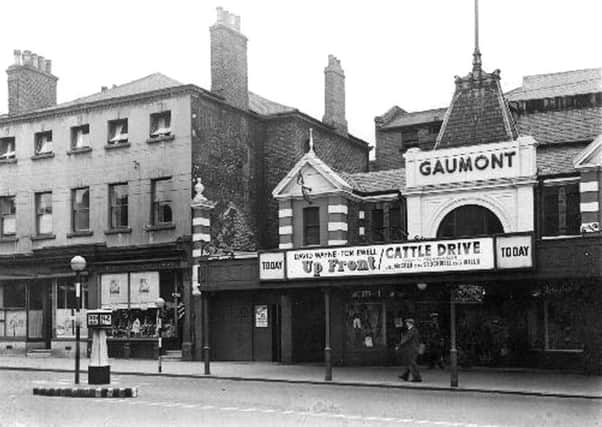Nostalgia on Tuesday: Talking pictures in Wakefield


Wakefield’s first permanent cinema opened in an upper floor in the Westgate Corn Exchange, on December 22, 1910. Built in 1838, the building had hosted a reading by Charles Dickens of A Christmas Carol in 1858. But dwindling trade by the turn of the 19th century meant other uses were then explored.
Shortly before Christmas 1910, reports stated considerable alterations had been carried out within the Corn Exchange’s Assembly Room. From the centre to the rear of the hall, the floor was gradually raised to 4ft 6in at the extreme end, ensuring every person had a good view of the screen. Initially, images were projected from a fire-proofed stand within the auditorium. At the outset, the cinema was known as the Electric but became the Grand Electric in 1911.
Advertisement
Hide AdAdvertisement
Hide AdWhilst the Cinematograph Act of 1909 rightly closed down many makeshift cinemas, it also set the scene for hundreds of purpose-built movie houses.
Wakefield city’s first purpose-built cinema was the Picture House, in Westgate. It was designed by Manchester architect Albert Winstanley, for local businessman, Sydney Tolfree. It opened on December 22, 1913, and was built at a cost of £13,000. The building included a small stage, orchestra pit and seated 1400. In 1915, the name was changed to the Playhouse and live theatre became part of the entertainment programme.
Tolfree had opened the Hippodrome, a variety theatre in the city, during 1910, and besides Wakefield, Tolfree was associated with entertainment ventures at Blackpool, New Brighton, Farnworth, Winsford, Todmorden and a director of the Spa (Scarborough) Ltd. The Hippodrome closed in 1922.
Wakefield’s second purpose-built cinema, the Carlton, in Grove Road, opened on September 14, 1914. It became Wakefield’s first cinema to offer a continuous entertainment programme from 6.30pm to 10.30pm.
Advertisement
Hide AdAdvertisement
Hide AdBefore the First World War the earliest cinemas were nothing more than basic rectangular rooms. During the heyday of cinemas – the 1920s and 1930s – buildings reflected designs of Egyptian temples and, latterly, a fascination for Art Deco styles. It was also a period which saw the growth of cinema chains.
The Theatre Royal and Opera House, Drury Lane, Wakefield, which Benjamin Sherwood had opened as a theatre in October 1894, to the designs of renowned theatre architect Frank Matcham, showed films instead of live shows in the summer of 1916.
In Tolfree’s Playhouse during 1921, a three-manual Conacher organ with 2,000 pipes was installed. The Empire Variety theatre, Kirkgate, built by the Sherwood family and designed by Frank Matcham, had opened in December 1909, but switched from variety to showing films exclusively from July 1921. Then, it was named the Empire Super Cinema.
The Grand Electric picture house in the Corn Exchange was acquired in 1929 by the Tolfree family for use as their second cinema. Known for frequently showing Westerns, the Grand Electric was eventually nicknamed the ‘Ranch House’.
Advertisement
Hide AdAdvertisement
Hide AdThe Carlton was taken over by Provincial Cinematograph Theatres in the 1920s and then by the Gaumont British Corporation in 1928. During the same year Gaumont took control of the Empire Super Cinema.
Founded in 1898 Gaumont-British was the subsidiary of the French
In competition with Gaumont, was another large cinema chain, Associated British Cinemas (ABC) founded in 1927 by Scottish solicitor John Maxwell. During the 1930s, ABC grew rapidly by acquisitions and an ambitious building programme. By the end of the Second World War, the company boasted over 400 cinemas (usually called the Savoy or Regal) and was second only to Rank’s Odeon and Gaumont chains.
ABC built Wakefield city centre’s only 1930s super cinema, the Regal, which opened at the corner of Sun Lane and Kirkgate on December 9, 1935. It formed a centrepiece for the local authority’s redevelopment scheme for that part of Wakefield.
Advertisement
Hide AdAdvertisement
Hide AdWith the introduction of television in the late 1940s, cinema audiences began to dwindle and this sounded the death knell in Wakefield as elsewhere. Closure for the Gaumont’s Empire Super Cinema came on July 30, 1960, and the premises were subsequently demolished.
Earlier in 1954, the Theatre Royal and Opera House was converted to a cinema and opened in the following year as the Essoldo. Closure as a cinema came on February 5, 1966, and afterwards the building was used by Essoldo (Bingo Ltd) and later Lucky Seven Bingo. It was reopened as a theatre in March 1986.
The Corn Exchange’s Grand Electric Cinema was sold by the Tolfree family to Sol Sheckman’s Essoldo chain in 1956. A year later fire badly damaged the building and it was demolished.
Tolfree’s Playhouse was later used as a skateboard centre but final closure came in June 1978. Thereafter, it became a nightclub and later a pub.
Advertisement
Hide AdAdvertisement
Hide AdPop stars performed at the Regal during the 1960s and included Helen Shapiro, Billy Fury and the Beatles. For a period in the 1960s and 1970s, the West Riding Operatic Society put on shows there. ABC was taken over by EMI in January 1969 who in turn were taken over by Thorn in December 1979, becoming Thorn EMI. Closure of Wakefield’s Regal/ABC came in 1997.
Further reading: Theatres & Cinemas of the Wakefield District by Kate Taylor